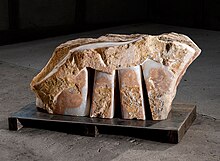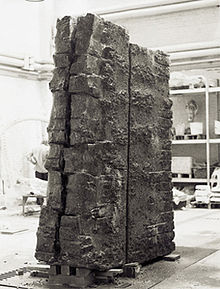Klaus Müller-Klug
Klaus Müller-Klug (* 1938 in Oldenburg ) is a German sculptor .
Life
The sculptor Klaus Müller-Klug was born in Oldenburg in 1938. From 1960 to 1965 he studied sculpture at the University of the Arts in Bremen under Gerhart Schreiter . In 1965, Klaus Müller-Klug moved to West Berlin with his wife, the sculptor Monika Müller-Klug . Together with the artists Georg Seibert and Emanuel Scharfenberg, he founded the "K 19 factory".
Klaus Müller-Klug has lived in the Lüchow-Dannenberg district since 1971 and continues to maintain a Berlin studio. In 1994 Klaus Müller-Klug founded the Damnatz sculpture garden together with his wife and supported by the Foundation for Sculpture , for which he created large-scale granite sculptures. In addition to these works, there are large-format free sculptures by 18 different artists on the 10,000 square meter site. In 1988 Klaus Müller-Klug was one of the founders of the "Westwendischer Kunsterverein".
Klaus Müller-Klug took part in various sculptor symposia (including): "International sculptor symposium E 88 in Berlin (European city of culture)", "10 from Europe for Potsdam (European sculptors in dialogue)". His work is represented in a wide variety of public collections (including: Sprengel Museum Hannover , Collection of the Lower Saxony State Government (Hannover), Collection of Contemporary Art of the Federal Republic of Germany (Bonn), Art and Exhibition Hall of the Federal Republic of Germany (Bonn), Berlin Gallery , Neuer Berliner Kunstverein , collection of the Senate of Berlin , collection of the Hanseatic City of Bremen .
Numerous large-scale sculptures by Klaus Müller-Klug are in public space (including): outdoor sculpture for the Free University of Berlin , fountain sculpture for the Paul Löbe Institute (Berlin), outdoor sculpture for the city of Potsdam, large granite stele in Queen Luise-Strasse (Berlin) , Free sculpture in front of the town hall of Dresden-Kellersdorf, stone sculpture in the Gartow lowland, market fountain for the city of Dannenberg.
Klaus Müller-Klug has three children. Till Müller-Klug is a writer and director, Ilja Müller-Klug is Sales Director of the Edel Verlagsgruppe in Hamburg and Florian Müller-Klug runs the art agency Artagent Berlin and the agency for historical city tours CLIO Berlin.
Klaus Müller-Klug was included with his work in the " artist database and estate archive Lower Saxony ".
plant
In his first artistic creative phase, Klaus Müller-Klug mainly worked with the materials bronze, copper and aluminum. In this section of the work, Klaus Müller-Klug created large-format aluminum sculptures.
“For Klaus Müller-Klug, aluminum was an important material, dominant for an entire section of the plant. This material, which is light in relation to other metals and, above all, easily malleable, created the best conditions for sculptural form principles such as B. by declining the vertical and horizontal alignment without losing sight of the substantive moment, the proximity to the figuration. At the same time, in contrast to bronze and copper, this metal requires formal rigor and distance, which is based on the close connection to technology and frequent use there. The GÖTZE from 1971/72 is an outstanding example of the successful symbiosis between allusion to and memory of archetypes and a sculpture shaped by the awareness of the technical age. Remembrance, not evocation, is the sculptural intention here: shapes of totems and idols, which are impressed on us in their mythical archaic like endogenous images, but only through the transformation into the secular language of the modern create new monuments of tension. These and other idol forms by Klaus Müller-Klug emerged at the time when art was in conflict between rigid minimalism and recourse to myths (Beuys or arte provera): an exciting, lasting debate. The GÖTZE is an example of the fact that even then they did not have to be mutually exclusive. "
Since the 1980s, Klaus Müller-Klug has been working increasingly with stone as a material, which he finally turned to completely. During this creative phase, Klaus Müller-Klug created small, medium and large-format stone sculptures of the most varied of materials. In addition to Italian and Persian marble, Klaus Müller-Klug prefers to work with hard plutonic or volcanic rocks such as granite and sometimes basalt.
“The stone, not a motif that has already been planned, has increasingly become a primary challenge for Klaus Müller-Klug. Unlike the stonemason, he does not look for a suitable material from which he can carve out a given figure in the best possible and effective manner, without annoying veins that cross a face or coarse-grained areas that resist polishing. Müller-Klug's path is reversed today: meanwhile a stone jester and collector, he orders stones from various quarries and regions. The selection is the original of the design with the aim of first and foremost getting on the track of the stone in its peculiarities and its material inventory, to bring it to oneself in its physical radiance and the associated auratic potency, to expose it as unmistakable . In various drawings he tries to approach each individual piece with this intention. The cuboid with atrium , created in 2000, is an exceptional example of how surface and core enter into dialogue with one another in the artist's work, and how stone in its diverse possibilities as nature and monument, load and support, as mass and shelter or warmth and coolness can reveal. "
Klaus Müller-Klug's oeuvre also includes drawings, etchings and small sculptures in cast bronze.
Exhibitions (selection)
- 1969 12 sculptors in the Folkwang Museum Essen
- 1970 Berlin sculptor in Budapest
- 1972 Villa Hammerschmidt, Bonn (Federal President's Office)
- 1973 Bellevue Palace, sculptor and painter with Hilda Heinemann
- 1970 German Association of Artists
- 1977 New Berlin Art Association
- 1977 Darmstadt Secession
- 1980 Linz cultural center
- 1983 International sculptor competition for the entrance area of the University of Berlin, 2nd prize winner
- 1983 German Association of Artists
- 1987 Ambiente marble, Germany, Italy
- 1987 Gallery for sculptor BH Berge, Berlin
- 1987 Staatliche Kunsthalle Berlin (acquisitions by the Berlinische Galerie)
- 1988 Sculpture in Berlin 1948–1988, Georg Kolbe Museum
- 1988 International Sculpture Symposium E 88, Berlin
- 1993 Symposium "10 from Europe for Potsdam"
- 1993 Salzgitter Art Association
- 2000 Westwendischer Kunstverein, Gartow
- 2003 Allen & Overy Hamburg
- 2005 Samtleben Gallery, Potsdam
- 2006 Edwin Scharff Museum, Neu-Ulm
- 2007 Art Association Uelzen
- 2007 Gallery "From chance and luck" in the cube in Hanover
- 2008 Heiddorf art space
- 2008 Hanseatic Bar Association Hamburg
Web links
| personal data | |
|---|---|
| SURNAME | Müller-Klug, Klaus |
| BRIEF DESCRIPTION | German sculptor |
| DATE OF BIRTH | 1938 |
| PLACE OF BIRTH | Oldenburg |



